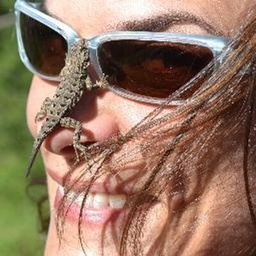
Sacha Vignieri
Deputy Editor at Science Magazine
Naturalist, biologist, observer, mother, editor at @sciencemagazine; opinions posted are mine alone
Articles
-
3 weeks ago |
science.org | Maria Fernandez |María Fernández |Pearse J. Buchanan |Brent Grocholski |Sacha Vignieri
Passive Cooling A cool paintBrent GrocholskiConceptual drawing of combined evaporative-radiative cooling paint. The top and exterior of buildings can be used to passively cool, but this requires materials with the right properties to do so effectively. Fei et al. designed a paint that cools both radiatively and through evaporation and that appears to keep buildings relatively cool even in humid environments.
-
1 month ago |
science.org | Karsten Schuhmann |Adam Shaw |Sacha Vignieri |Jelena Stajic
Evolutionary Biology A bevy of behemothsSacha VignieriArtist’s illustration of the giant ground sloth, Megatherium americanum, one of many sloth species that thrived in the Americas before human arrival. ILLUSTRATION: MAURICIO ANTON/SCIENCE SOURCEToday, there are six species of sloths, all of which have similar ecologies such as arboreality and a slow metabolism. These species are a tiny remnant of a once diverse American clade that was mostly made up of large-bodied species. Boscaini et al.
-
1 month ago |
science.org | Karsten Schuhmann |Adam Shaw |Sacha Vignieri |Stella Hurtley
Wildlife Disease A grim and unknown tollSacha VignieriAvian influenza, H5N1, has affected birds for decades. Less well known are its catastrophic effects in marine mammal populations, with recent estimates of mortalities in the tens of thousands across species. Campagna et al. modeled the long-term consequences of an H5N1 outbreak in an Argentine breeding colony of southern elephant seals in 2023 that killed nearly all the pups and an unknown number of adults.
-
1 month ago |
science.org | Sarah Crespi |Sacha Vignieri |Jonathan Moens
frans lemmens/Alamy Stock Photo First up on the podcast, freelance journalist Jonathan Moens talks with host Sarah Crespi about a forensic test called brain electrical oscillation signature profiling, which police in India are using along with other techniques to try to tell whether a suspect participated in a crime, despite these technologies’ extremely shaky scientific grounding. Next on the show, scientists have recently made strides in our understanding of horses, from identifying the...
-
2 months ago |
science.org | Guan Wang |Jedediah F. Brodie |Thao-Quyen Nguyen |Sacha Vignieri
Natural History The bone collectorSacha VignieriBone collector caterpillars, seen here, evade detection by forming a portable case made of discarded insect body parts. PHOTO: UNIVERSITY OF HAWAII INSECT SYSTEMATICS AND BIODIVERSITY LABThe vast majority of lepidopteran caterpillars are herbivorous. Those that break this rule tend to do so in unexpected ways, such as the Hawaiian inchworm, which is an ambush predator. Rubinoff et al.
Try JournoFinder For Free
Search and contact over 1M+ journalist profiles, browse 100M+ articles, and unlock powerful PR tools.
Start Your 7-Day Free Trial →X (formerly Twitter)
- Followers
- 1K
- Tweets
- 13K
- DMs Open
- No

#besidesus

A Western Citril in ‘rocket mode’… Photographed @golf_kigali in #Kigali #Rwanda #RwOT #TwitterNatureCommunity #VisitRwanda https://t.co/mtqCU2atSn

#besidesus

Really looking forward to going home to #Rwanda next week. Until then I will be posting images to highlight the country’s stunning avian diversity. I’ll start with one of my favourites, the Malachite Kingfisher. Photographed @golf_kigali #visitRwanda #TwitterNatureCommunity https://t.co/6hDUxZKah3

#besidesus

A Ross’s Turaco on the move… Photographed in Nyarutarama, #Kigali #Rwanda #RwOT #TwitterNatureCommunity #VisitRwanda https://t.co/iGtkkTj27D






